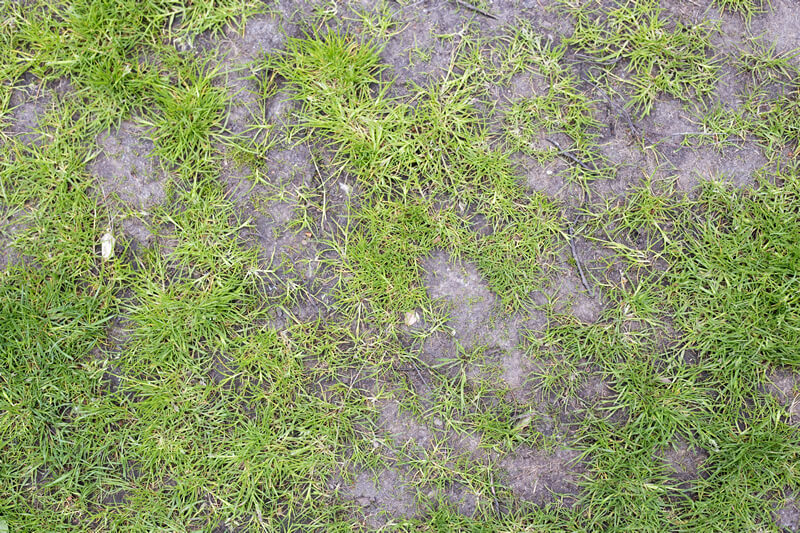Why deal with lawn compaction?
- Not dealing with lawn compaction will make it very difficult to grow a healthy lawn, regardless of whether you have the right lawn treatments in place
- Excessive compaction will prevent essential moisture, nutrition, and oxygen from reaching the grass roots
- Compacted lawns have weaker grass that suffers more from Red Thread disease and Fusarium Patch
- Compacted lawn soil will be waterlogged, creating the ideal environment for moss growth. Shrekfeet provide a waterlogged lawn treatment.
- Compaction builds up over time. It’s good practice to aerate a lawn regularly as part of your standard cultural practices. Prevention is always better than cure
What causes lawn compaction?
How can I deal with a compacted lawn?
How can I prevent and reduce lawn compaction?
Lawn compaction briefly explained…
- Air space in soil is essential for grass root development, drainage, and airspaces
- Regular foot traffic can cause compacted areas of soil
- Compaction means your turf will get less air and water to the roots as there are fewer holes in the soil
- If you have regular walking routes over your lawn, then these will soon become compacted
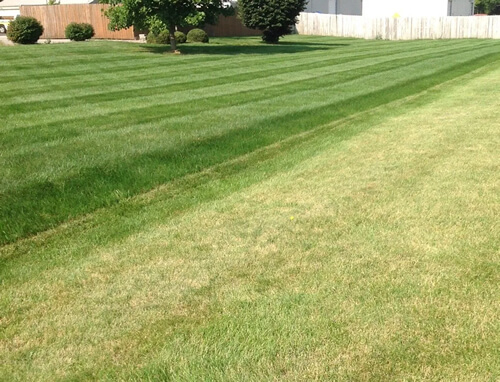
Lawn aeration improves root development
What is lawn compaction and how does it happen?
Soil should contain many air spaces. Water drains through these holes, preventing the soil from becoming waterlogged. These air spaces can become reduced through compaction. This is caused by compression of the soil due to weight applied to it from above. This might be something as simple as a dog that always runs the same route through the garden. Walking over the lawn to peg out washing or to reach the shed or the process of using a mower.
Why is compaction a problem?
The roots of your lawn don’t grow in soil. Roots grow in the air gaps within the soil. If the soil is compacted, then your lawn grass will have fewer roots or shorter roots. Compromised root development is really bad resulting in a lawn that is not healthy. Roots are essential for accessing moisture, absorbing nutrients and are also responsible for an exchange of gasses between the plant and the atmosphere. In addition, these air spaces help the soil to drain. Without them the soil becomes waterlogged creating other related issues through the growing season.
Lawn compaction, moss, pests, and diseases
Moss likes a damp environment. Compacted, poorly drained lawns will be mossier. Grass trying to grow in a compacted lawn will weaker due to poor root development. This grass will be less able to defend itself against the problems caused by pests and diseases. To avoid excessive risk of lawn diseases it’s important that the lawn is well drained, and compaction certainly doesn’t help with this. Take a look at areas around gates, sheds, and pathways where the grass isn’t growing well. This is usually because the soil is compacted.
Compaction, nutrition, and drought problems
If your lawn is compacted and roots development isn’t to the correct depth, the basic functions of the plant are compromised. The plant struggles in its search for nutrients as it has fewer deep roots than it needs to thrive. In these conditions plants don’t respond as they should to the application of fertiliser and fertiliser not used by the plants will wash away. This can be bad for the environment. In addition, compacted soils don’t behave as they should with water. This tends to sit on the surface causing waterlogging above and often dry soil below. Water doesn’t pass through the soil in the right way and compacted soil can be hard to water during periods of drought as water applied to the surface doesn’t reach the root-zone.
Compaction, soil biology and lawn thatch
Beneficial soil microbes need air to survive. If the soil is compacted and there is less air in the soil, then the population of microbes will be lower. These microbes are essential to the breakdown and digestion of organic matter. Without them the lawn is more likely to suffer from thatch issues which is a major problem
When is the best time to aerate your lawn?
The best time to aerate your lawn is when the soil is moist but not too wet. Spring or autumn are the ideal time. Avoid summer if hot, dry weather is expected as using a machine to break through the surface of the soil compaction can result in excessive drying in times of drought.
How to aerate your lawn
- Smaller areas can be aerated using the tines of a garden folk. Rock it back and forwards in the soil to create cracks under the surface
- Larger lawns require a specialist, powered aerator. Either walk-behind or tractor-mounted
- Aeration is about making holes in the surface and sub-surface cracks through soil displacement
- Aerate your lawn regularly to relieve compaction before it becomes a problem. At least once a year
- Remove cores or plugs of soil with a powered aerator
- Avoid machine aeration when the soil is very wet as this can cause further issues
- Avoid aeration when the weather is very dry or hot as this can cause the soil to dry out more quickly
What are the different types of aerators?
- Hollow-tine aerators remove a small plug from the lawn, leaving a hole for the surrounding soil to ‘relax’ into creating more air spaces.
- Solid-tine aerators punch holes through the surface and fracture the soil underneath
- Fracture-tines are off-set blades that enter the soil and push it to one side as they leave, again creating fracks and fissures
- Pencil-tine aerators are the same as solid tine
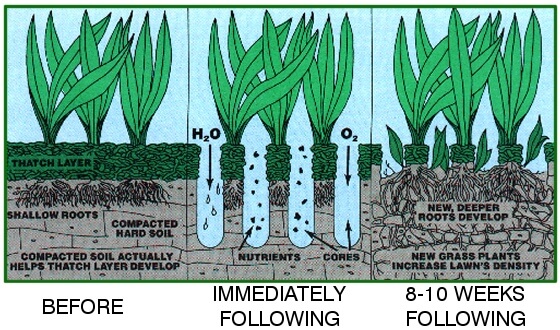
Aeration encourages root development
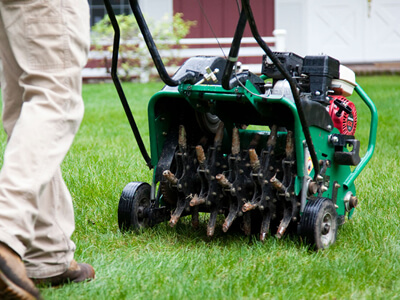
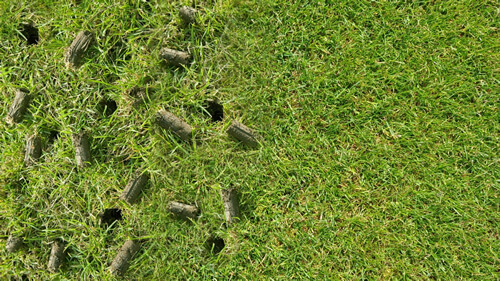
Aeration boosts the soil health

 Established 2016
Established 2016
